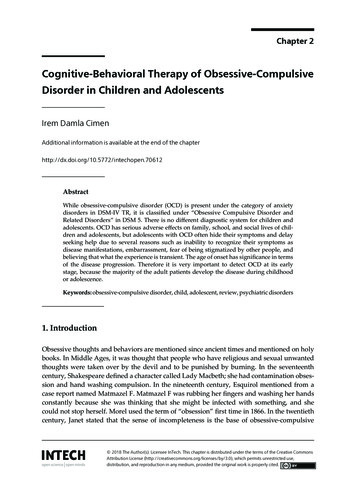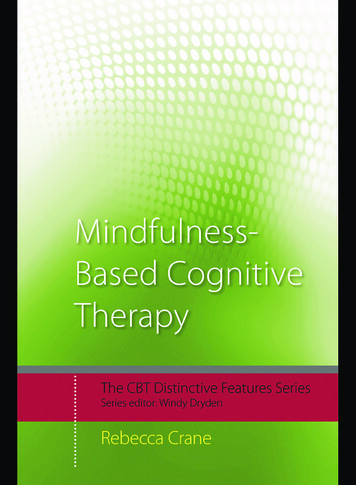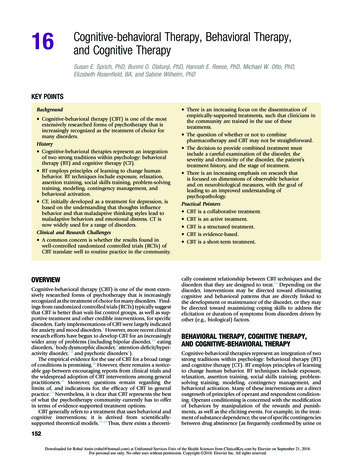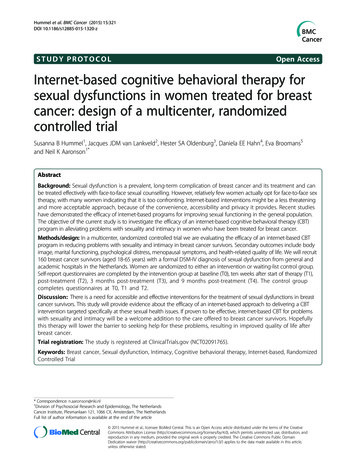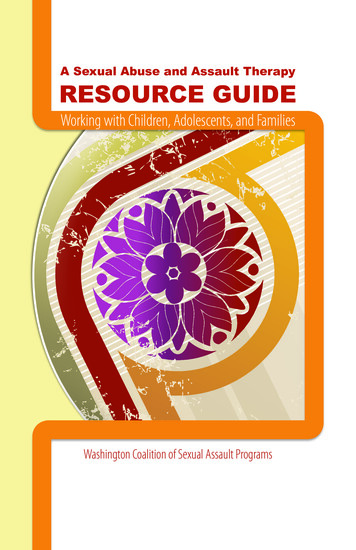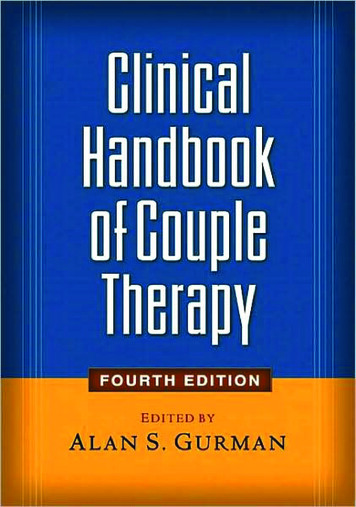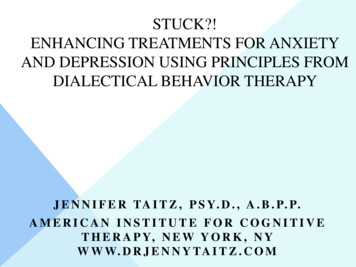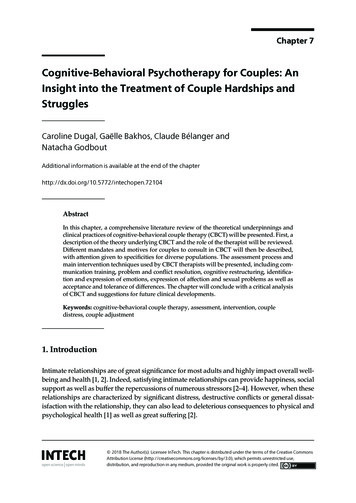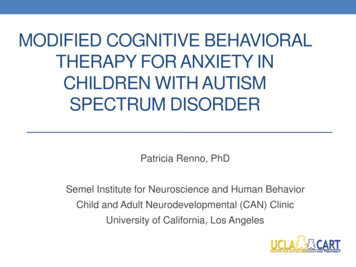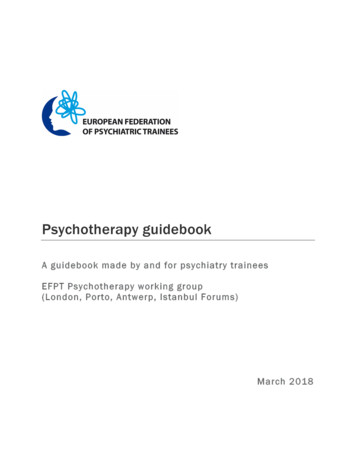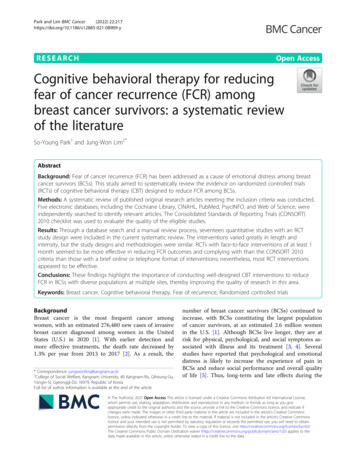
Transcription
Park and Lim BMC Cancer(2022) SEARCHOpen AccessCognitive behavioral therapy for reducingfear of cancer recurrence (FCR) amongbreast cancer survivors: a systematic reviewof the literatureSo-Young Park1 and Jung-Won Lim2*AbstractBackground: Fear of cancer recurrence (FCR) has been addressed as a cause of emotional distress among breastcancer survivors (BCSs). This study aimed to systematically review the evidence on randomized controlled trials(RCTs) of cognitive behavioral therapy (CBT) designed to reduce FCR among BCSs.Methods: A systematic review of published original research articles meeting the inclusion criteria was conducted.Five electronic databases, including the Cochrane Library, CINAHL, PubMed, PsycINFO, and Web of Science, wereindependently searched to identify relevant articles. The Consolidated Standards of Reporting Trials (CONSORT)2010 checklist was used to evaluate the quality of the eligible studies.Results: Through a database search and a manual review process, seventeen quantitative studies with an RCTstudy design were included in the current systematic review. The interventions varied greatly in length andintensity, but the study designs and methodologies were similar. RCTs with face-to-face interventions of at least 1month seemed to be more effective in reducing FCR outcomes and complying with than the CONSORT 2010criteria than those with a brief online or telephone format of interventions; nevertheless, most RCT interventionsappeared to be effective.Conclusions: These findings highlight the importance of conducting well-designed CBT interventions to reduceFCR in BCSs with diverse populations at multiple sites, thereby improving the quality of research in this area.Keywords: Breast cancer, Cognitive behavioral therapy, Fear of recurrence, Randomized controlled trialsBackgroundBreast cancer is the most frequent cancer amongwomen, with an estimated 276,480 new cases of invasivebreast cancer diagnosed among women in the UnitedStates (U.S.) in 2020 [1]. With earlier detection andmore effective treatments, the death rate decreased by1.3% per year from 2013 to 2017 [2]. As a result, the* Correspondence: jungwonlim@kangnam.ac.kr2College of Social Welfare, Kangnam University, 40 Kangnam-Ro, Giheung-Gu,Yongin-Si, Gyeonggi-Do 16979, Republic of KoreaFull list of author information is available at the end of the articlenumber of breast cancer survivors (BCSs) continued toincrease, with BCSs constituting the largest populationof cancer survivors, at an estimated 2.6 million womenin the U.S. [1]. Although BCSs live longer, they are atrisk for physical, psychological, and social symptoms associated with illness and its treatment [3, 4]. Severalstudies have reported that psychological and emotionaldistress is likely to increase the experience of pain inBCSs and reduce social performance and overall qualityof life [5]. Thus, long-term and late effects during the The Author(s). 2021 Open Access This article is licensed under a Creative Commons Attribution 4.0 International License,which permits use, sharing, adaptation, distribution and reproduction in any medium or format, as long as you giveappropriate credit to the original author(s) and the source, provide a link to the Creative Commons licence, and indicate ifchanges were made. The images or other third party material in this article are included in the article's Creative Commonslicence, unless indicated otherwise in a credit line to the material. If material is not included in the article's Creative Commonslicence and your intended use is not permitted by statutory regulation or exceeds the permitted use, you will need to obtainpermission directly from the copyright holder. To view a copy of this licence, visit http://creativecommons.org/licenses/by/4.0/.The Creative Commons Public Domain Dedication waiver ) applies to thedata made available in this article, unless otherwise stated in a credit line to the data.
Park and Lim BMC Cancer(2022) 22:217cancer survivorship phase require posttreatment survivorship care.Of the diverse forms of psychological distress that BCSsexperience, fear of cancer recurrence (FCR) is known tobe one of the most prevalent, persistent, and disruptiveproblems [6–8]. FCR is generally defined as “fear, worry,or concern about cancer returning or progressing” [8].Approximately 50% of BCSs report moderate-to-high FCRlevels [9]. A few studies have also reported that up to 70%of BCSs experience FCR, which is associated with longterm functional impairments [10, 11].FCR can negatively influence screening, health behaviors, mood, coping behaviors, and quality of life [10, 12].BCSs also tend to report an unmet need for help withFCR at treatment completion, suggesting that the management of FCR may be their greatest unmet need [8,13]. More specifically, previous studies have showed thatBCSs with FCR use maladaptive coping strategies, suchas excessive reassurance seeking, anxious avoidance, intrusive thoughts, denial, or self-blame [14–16]. For example, intrusive thoughts about the cancer andtreatment occurred even years after the completion oftreatment [17]. Although BCSs are expected to live longer after cancer treatment, if their psychological distressis left untreated, debilitating fears may continually influence their remaining lives, thereby reducing their qualityof life [8, 18].Since FCR is significant as a cause of emotional distress among BCSs, FCR should be addressed as a logical,clinically relevant target for intervention [19, 20]. Giventhat FCR is associated with coping behaviors and unmetneeds, cognitive behavioral therapy (CBT) may be acommon psychotherapeutic intervention for BCSs withFCR [21]. Indeed, CBT has proven to be more effectivethan usual care in reducing FCR, with reported effectsizes of 0.20 to 0.73 [22–24]. There is a growingbody of research on interventions based on CBT forFCR. Although the theoretical foundations, formats anddelivery methods of these interventions differ, the available interventions are based on CBT [25]. For example,the effectiveness of CBT, including problem-solvingtherapy and behavioral activation, in reducing FCR hasbeen shown among BCSs, indicating that problemsolving therapy contributes to survivors’ better copingwith situations that commonly trigger FCR [21]. CBT interventions, including mindfulness stress reduction,acceptance and mindfulness, and compassion-based interventions were also known to improve FCR for BCSs[24, 26, 27]. That is, acceptance and commitmenttherapy, which emphasizes acceptance while livingmindfully according to one’s values, was effective in facilitating the adaptive management of FCR for BCSs[28]. Mindfulness-based interventions tend to emphasizeawareness to induce physiological relaxation and helpPage 2 of 15individuals emotionally disconnect from depressingthought patterns [29, 30]. Recently, several studies foundthat mindfulness-based interventions were effective ascoping strategies that diminish anxiety, stress, and general mood and enhance quality of life for BCSs [31, 32].The evidence on compassion-based interventions designed to generate cognitive compassionate habits alsosuggests that they can provide useful skills to preventFCR for BCSs [33].Tauber and colleagues [34] evaluated the effects ofpsychological intervention on FCR in a systematic reviewand meta-analysis, and indicated that larger postintervention effects were found for interventions that werefocused on the processes, rather than the content of cognition. Given that Tauber and colleagues [34] includedboth controlled and open trials among patients with andsurvivors of cancer, systemic reviews of more rigorousinterventions focusing on randomized controlled trials(RCTs) are required to provide a comprehensive overview of current knowledge on CBTs designed to reduceFCR among BCSs. Additionally, earlier studies on CBTshave not fully considered methodological approachesbased on the Consolidated Standards of Reporting Trials(CONSORT) 2010 statement [35]. Systemic reviews onCBTs using rigorous methodologies will be helpful to fillgaps in the literature by examining the reported effectsof CBTs on FCR for BCSs.The purpose of this study is to conduct a systematicreview of RCTs with CBT interventions for reducingFCR among BCSs who have completed active treatment.More specifically, this systematic review study evaluatesRCT interventions with regard to the content and methodological aspects of the interventions, the FCR outcomes, and the quality of the studies.MethodsSearch strategy and sourcesThe Preferred Reporting Items for Systematic Reviewsand Meta-Analyses (PRISMA) statement [36] was used asa basis for screening and selecting studies. The CochraneLibrary, CINAHL, PubMed, PsycINFO, and Web of Science databases were systematically searched between July13, 2020, and July 15, 2020, to identify relevant studies.The key search terms were (breast) AND (cancer OR carcinoma OR neoplasm) AND (fear* OR concern OR worr*OR anxiet*) AND (recur* OR relapse OR progress*) AND(cognitive behav* therap*). One of the authors (S.P.) performed all searches. In addition to the database search,the bibliographies of all included articles were manuallyscreened to identify other relevant articles.Selection strategyTo select eligible studies, the following PICOTS-SD criteria were applied: (1) Participants (P): female breast
Park and Lim BMC Cancer(2022) 22:217cancer survivors who had completed active treatment(e.g., surgery, chemotherapy, etc.); (2) intervention (I):CBT interventions; (3) comparison (C): usual care, otherpsychological intervention, or no intervention; (4) outcome (O): quantitative FCR outcomes using FCR-relatedmeasures; (5) time (T): pretest, posttest, and follow-up;(6) setting (S): hospitals or community-based organizations; and (7) study design (SD): RCTs. Furthermore, thestudies had to be written in English and published fromJanuary 2010 to July 2020. We excluded review articles,books and book chapters, qualitative studies, commentaries, editorials, poster abstracts, case reports, articleson childhood survivorship populations or without control groups, and original studies without full texts.Data extractionFirst, the titles and abstracts of the potential eligible records were reviewed. Second, duplicates and unsuitablearticles were removed from the records. Then, the articles that fulfilled the inclusion criteria were subsequentlyobtained in full text and examined by the authors (S.P.and J.L.). Any discrepancies regarding a study’s inclusionor exclusion were discussed as a group and were resolved by consensus. For each study, two authors (S.P.and J.L.) extracted the first author’s name, publicationyear, country of study, sociodemographic and cancerrelated characteristics, sample size, study design, description of the CBT interventions, FCR measures, and summary of the primary outcome findings.Quality assessmentThe CONSORT 2010 statement [35] was utilized to assessthe methodological quality of all included studies. TheCONSORT 2010 statement is a 37-item checklist that includes all aspects of reporting, such as the title and abstract, introduction, methods, the results, discussion, andother information. In the present review, four of 37 items(e.g., any changes to trial outcomes after the trial commenced, with reasons [6b]; if relevant, description of thesimilarity of interventions [11b]; why the trial ended orwas stopped [14b]); and for binary outcomes, presentationof both absolute and relative effect sizes is recommended[17b]) were not used for quality assessment because theywere not applicable to the included studies. The authorsreviewed the selected articles according to the CONSORT2010 checklist and rated them as “yes” or “no.” If the articles described each of the 33 checklist items, they werecategorized as “yes.” In contrast, if the articles did not report adequate information or lack of information on theseitems, they were evaluated as “no.” Then, the number andproportion of the included studies reporting each applicable item on the checklist were calculated. Any disagreements were discussed by the authors (S.P. and J.L.) untilconsensus was reached.Page 3 of 15ResultsStudy selectionA total of 333 studies were extracted from the online databases and other sources (e.g., bibliographies of all includedstudies). After the removal of duplicates and ineligible records, 276 records were screened. Based on the evaluationof the titles and abstracts, 237 articles were excluded because they were not relevant, with common reasons forexclusion (e.g., no breast cancer survivors, no RCT studydesign, no CBT intervention, no data on FCR, and abstractonly). Then, 25 full-text articles were assessed for secondary screening, of which eight studies were excluded for thereasons described in Fig. 1. After a review and discussionamong authors, 17 articles were finally selected for thesystematic review (see Fig. 1 for PRISMA flow diagram ofthe literature review).General characteristics of the interventionsA summary of the general characteristics of the studyparticipants, including the sample size, age, sex, ethnicity, cancer type, cancer stage, and time since diagnosis,is listed in Table 1. Of the included studies, most studieswere conducted in the U.S. (n 8), the Netherlands (n 2), or Germany (n 2), and other countries representedwere Spain, Belgium, Canada, Australia, and Japan. Thetotal sample size across the studies was 2288 participants, with the sample sizes of each study ranging from24 to 322. The participants in the sample were predominately non-Hispanic White females, with an average ageof 53.1 years. Most studies focused on only breast cancersurvivors (n 12), while some studies included mixedcancer populations (n 5). Most of the studies recruitedcancer survivors diagnosed at stages 0 to 3 or stages 1 to3, but two studies included people with stage 4 cancer.The means of time since diagnosis for the experimentaland control groups were 4.48 and 4.49 years, respectively, which indicated that the study participants hadcompleted their treatment rather recently.Content and methodological strategies of theinterventionsFirst, the included interventions utilized a wide range ofCBT techniques with some variations, such as mindfulness awareness practices (MAPS) [37], acceptance andcommitment therapy (ACT) [26, 38], cognitively basedcompassion training (CBCT) [39, 40], mindfulness-basedstress reduction (MBSR) [27, 41], mindfulness-basedcognitive therapy (MBCT) [42], attention and interpretation modification [43], cognitive-existential psychotherapy [44], blended CBT [24], and CBT-based online selfhelp training [45].More than half of the studies used group-based interventions, while six studies adopted an individual format.One of the group intervention studies targeted breast or
Park and Lim BMC Cancer(2022) 22:217Page 4 of 15Fig. 1 PRISMA Flow Diagram of the Literature Searchgynecological cancer survivors and their partners [46].Most interventions were delivered face-to-face, and onestudy combined in-person delivery with an onlinemethod [24]. A couple of studies used either telephonecommunication [47, 48] or online communication [45].The frequency and duration of the interventions variedgreatly, from a single 20- to 45-min session [47] to 15weekly 2-h sessions [49]. The most common intervention duration was six or 8 weeks (n 9). The CBT interventionists included heath care professionals such aspsychotherapists, psychologists, or nurses. The threat ofselection bias was low because all the studies utilized apretest-posttest control group design with random assignment. Most studies included an active comparisongroup and/or a control group with usual care during theintervention period. In particular, Herschbach et al. [23]compared a CBT group with a comparison group (supportive-experiential group) and a control group, andButow et al. [26] compared a CBT group with a comparison group that received a relaxation training program. Johns et al. [38] included both a comparisongroup (e.g., survivorship education) and a control groupand compared these groups with a CBT group. Six studies [27, 37, 39, 41, 42, 44] compared a CBT group with awaitlisted control group. Last, there were limitations regarding a lack of external validity (e.g., small and highlyhomogeneous samples, the same settings and regions inthe U.S. or European countries) in most studies. However, Germino et al.’s [48] study targeted both nonHispanic Whites and African Americans, and Butowet al. [26] recruited samples from 17 oncology centers inAustralia.FCR instrumentsFive different instruments were used to measure FCR inthe selected studies: the Cancer Worry Scale (CWS)
Total: 56.6(9.7), MBSR: 57.6(9.2),Control: 56.5(10.2)Total: 46.9 MAPS: 46.1, Control:47.7Total: 58.7(10.7), ACT: 59.8(11.1),SE: 57.5(10.5),EUC: 58.7(10.5)322Bower et al. [37], USA 719128568274Lengacher et al. [27],USAJohns et al. [38], USADodds et al. [39],USAGonzalez-Hernandezet al. [40], SpainLengacher et al. [41],USAPark et al. [42], JapanTotal: 54.9, AIM-FBCR: 55.8(7.4),Control: 53.9(10.3)Total: 55.0 (10.8), CEP: 53.9(13.5),Control: 56.0(8.3)Lichtenthal et al. [43], 97USATomei et al. [44],CanadaTotal: 53.7, MBCT: 53.2(8.4),Control: 54.2(9.3)Total: 57.2(9.2)Total: 52.1 (7.0), CBCT: 51.6(6.9),TAU: 52.6(7.2)Total: 55.3, CBCT: 54.7(12.1),Control: 55.8(9.7)Total: 52.8(10.1), ConquerFear53.3(10.5), Control 52.3(9.6)222Butow et al. [26],AustraliaTotal: 52.5, Patient: 52.2(11.3),Partner: 52.7(11.4)18045313159Heinrichs et al. [46],GermanyShields et al. [47],USAGermino et al. [48],USAMerckaert et al. [49],BelgiumDutch95.8% non-Hispanic WhitesAIM-FBCR: 73.0% non-HispanicWhites, Control: 75% non-HispanicWhitesJapanese71.9% non-Hispanic WhitesSpanishNon-Hispanic Whites83.52% non-Hispanic Whites76.1% Non-Hispanic Whites69.4% non-Hispanic WhitesAustralianDutch100% female100% female100% femaleBelgian117 African American, 196 nonHispanic Whites97.5% non-Hispanic WhitesPatient group: German100% female100% female100% female100% female100% female100% female100% female100% female100% female100% female100% female95% female53% femaleGermanEthnicityCancerStageTime Since Diagnosisin Years (Mean, SD)BreastBreastBreastBreast or gynecologicalcancerBreastBreast, gynecological andocular BreastRange: 0-6,CEP: 1.91(1.30), Control:1.23(1.23)No informationMBCT: 3.27(3.10), Control:3.43(5.41)No informationCBCT: 11.32(1.44),Control: 10.46(2.90)CBCT: 4.8(3.2), Control:5.8(6.0)No informationMAPS: 4.0(2.4), Control:4.1(2.3)No information1-31-41-30-3No informationNo informationCBT: 5.6(1.7), Control:5.5(1.6)No informationNoCBT: 2.5(1.1), Control:information 2.6(1.2)1-30-30-30-31-31-41-30-30-3ConquerFear (median):2.26, control(median):2.43NoCBT: 2.4(1.5), CAU:information 2.8(1.3)Mixed (breast, colorectal, or 0-3melanoma)Breast, prostate, andcolorectal cancerBreast, colorectal, bladder/ NoNo informationprostate, gynecological, etc. informationCancer Type(2022) 22:217Total: 50.6 (10.1)Total: 44Total: 44.1, CBT: 44.2(5.0),Control: 44.0(4.1)Total: 55.8(9.9), CBT: 55.3(10.1),CAU: 56.2(9.8)van Helmondt et al.262[45], The Netherlands24SexTotal: 53.7(10.2), CBT: 53.7(9.6),85.7% femaleSET: 53.8(10.6), Control: 53.7(10.3)Total: 58.9, CBT: 58.0(11.3), CAU:59.7(10.0)174Herschbach et al.[23], GermanyAge at Survey (Mean, SD)van de Wal et al. [24], 88The NetherlandsSample size(TotalSample)Author, CountryTable 1 General characteristics of the reviewed articlesPark and Lim BMC CancerPage 5 of 15
Mindful awarenesspractices (MAPS)ACTBower et al.[37], USAJohns et al.[38], USAFace-tofaceCBCTMindfulness-based stressreduction (MBSR(BC))Mindfulness-basedcognitive therapy (MBCT)Attention andInterpretation ModificationGonzalezHernandezet al. [40],SpainLengacheret al. [41],USAPark et al.[42], JapanLichtenthalet al. dual 3 online)4Number ofSessions4Duration(Weeks)86886661030 minutes 42 hours2 hours2 hours2 hours2 hours2 hours2 hours1 to 1.5hours1 hour 1215 minutes1.5 hoursSessionLengthStudy DesignA parallelCare as usualgroup,prospectiverandomizedcontrolled trial1) Supportiveexperientialgroup therapy,2) omassignment toone of twointerventions, butnot for thecontrol groupRandomization(Selection Bias)No informationPsychologists,psychiatrists,and nursesPsychologistPsychologistSocial workresearcherDoctoral-leveltherapistNo informationPsychologist1) Survivoreducation, 2)Enhancedusual careWaitlistedcontrolA parallelgroupControlconditionA randomized Waitlistedcontrolled trial controlA randomized Waitlistedcontrolled trial controlA randomized Treatment-ascontrolled trial usual controlA randomized Waitlistedwait listcontrolcontrolled trialdesignA randomizedcontrolledpilot trialA singlecenter, twoarmed RCTA randomized Waitlistedcontrolled trial controlMostly nonHispanicConducted inJapanRandomassignmentRandomassignmentMostly nonHispanicWhitesConduced inSpainMostly nonHispanicWhitesMostly nonHispanicWhitesMostly nonHispanicWhitesMostly nonHispanicWhitesMultiplecenters indifferent areasin AustraliaFive hospitalsin theNetherlandsTworehabilitationclinics domassignmentRandomassignmentPsychologists or A randomized A nonspecific Randompsychiatristscontrolled trial attentionassignmentcontrol(Taking-it-Easy:a erapists A st(2022) 22:217GroupGroupFace-tofaceFace-tofaceDodds et al. Cognitively basedGroup[39], USAcompassion training faceMBSRLengacheret al. [27],USAGroupFace-tofaceButow et al. Meta-cognitive therapy,Individual[26],Self-Regulatory ExecutiveAustraliaFunction (S-REF) model,and Acceptance andcommitment therapy (ACT)Face-tofaceDeliveryModeFace-toface chet al. [23],Germanyvan de Wal Blended CBTet al. [24],TheNetherlandsCBT Intervention TypeAuthor,CountryTable 2 Content and methodological strategies of the interventionsPark and Lim BMC CancerPage 6 of 15
sed online self-helpHelmondttraininget al. [45],TheNetherlandsHeinrichs et Couples-based skillsal. [46],intervention (side by side)GermanyShields etCoaching interventional. [47], USA (prompt plus telephonecounseling)Germino et Cognitive and behavioralal. [48], USA strategiesMerckaertet al. [49],BelgiumCognitive behavioraltechniques and hypnosisIndividualfor Fear of Breast CancerRecurrenceUSAInterventionFormatTomei et al. Cognitive-existential[44], Canada psychotherapy (CEP)CBT Intervention TypeAuthor,Country466Number ofSessionsFace-toface15Telephone 4Telephone (Weeks)182 hours1520 minutes 4 6months20 to 45minutes2 hoursno12information2 hoursSessionLengthTable 2 Content and methodological strategies of the interventions (Continued)PsychologistsNursesNursePsychologistsNo ction Bias)Usual careControlprogramA multicenter Enhancedrandomizedstandard carecontrolled trialA2x2randomizedblock,repeatedmeasuresdesignA randomizedpilot trialA oupdesignA randomized Care as usualcontrolled trial (psychologicalor othersupport)A pilotWaitlistedrandomizedcontrolcontrolled trialrandomizedtrialStudy DesignMultiplecenters inBelgiumnon-HispanicWhites andAfricanAmericansSmall andhomogeneoussampleThree regionalhospitals inGermanyEight hospitalsin theNetherlandsMostly nonHispanicWhitesWhitesExternalValidityPark and Lim BMC Cancer(2022) 22:217Page 7 of 15
Park and Lim BMC Cancer(2022) 22:217Page 8 of 15[50], the Concerns about Recurrence Scale (CARS) [51],the Fear of Cancer Recurrence Inventory (FCRI) [52],the short form of the Fear of Progression Questionnaire(FoP-Q-SF) [53], and the Quality of Life in Adult CancerSurvivors (QLACS)-FCR subscale [54]. Among these instruments, the FCRI (42 items) and the CARS (30 items)were the most frequently used in the included studies.Eight studies [24, 26, 38–40, 44, 45, 49] used either theFCRI total scale or some of the seven FCRI subscales(e.g., triggers [8 items], severity [9 items], psychologicaldistress [4 items], coping strategies [9 items], functioningimpairments [6 items], insight [3 items], and reassurance[3 items]). Six studies [27, 41–43, 47, 48] used the 30item CARS, which is composed of two measures: overallfear and a range of problems. Van de Wal et al. [24]used both the 8-item CWS and FCRI, and other studiesmeasured FCR by using either the 12-item FoP-Q-SF[23, 46] or the 4-item QLACS-FCR subscale [36]. Table 3provides a summary of instruments used to assess FCR.assessed FCR only at baseline or pretest (T0) and posttest (T1), and other studies assessed FCR scores at baseline or pretest, posttest, and one or two follow-upperiods. Most studies showed significant reductions inthe FCR scores of the intervention groups at the postintervention and follow-up time points, but some resultswere not statistically significant. In particular, threestudies [45, 47, 48] reported no significant betweengroup differences in FCR across time. The common aspects of these studies were a telephone or online formatand brief sessions of less than 1 h. Seven studies [23, 26,27, 41, 42, 44, 46] reported both significant main effectsin the intervention groups and significant group-by-timeinteraction effects on all FCR scores over time. In general, these interventions were in four to eight 60- to120-min, face-to-face group sessions over at least 4weeks and the interventionists were trained health careprofessionals such as psychotherapists and psychiatrists.In addition, seven studies using either the FCRI or theCARS subscales [24, 38–40, 43, 47, 49] showed partiallysignificant improvements in a couple of subscales amongthe intervention groups. Interestingly, two studies [23,38] included three arm RCTs to compare CBT with acomparison group (e.g., supportive-experiential grouptherapy, survivor education) and a control group andFCR-related outcomesThe FCR-related outcomes of all studies are listed inTable 4. FCR was included as an outcome variable inmost studies except Lengacher et al.’s study [41], whichtreated FCR as a mediator. Three studies [24, 41, 49]Table 3 Instruments used to assess fear of recurrenceName of FCR InstrumentComposite MeasureCancer Worry Scale (CWS) [50]Concerns about Recurrence Scale(CARS) [51]1) Overall fear (or concerns)Numberof ItemsResponseFormatStudies Using Each MeasureTotal: 81 4van de Wal et al. [24]41 6Germino et al. [48], Lengacher et al. [41], Lengacheret al. [27], Lichtenthal et al. [43], Park et al. [42]0 4Lengacher et al. [41], Lengacher et al. [27],Lichtenthal et al. [43], Shields et al. [47]2) Problems (death, health, role, 26womanhood, and parenting)Total: 30Fear of Cancer Recurrence Inventory(FCRI) [52]1) Triggers80 4Dodds et al. [39], Gonzalez-Hernandez et al. [40],Johns et al. [38], Merckaert et al. [49]2) Severity90 4Dodds et al. [39], Johns et al. [38]Merckaert et al. [49], van Helmondt et al. [45]3) Psychological distress40 4Dodds et al. [39], Gonzalez-Hernandez et al. [40],Johns et al. [38], Merckaert et al. [49]4) Coping strategies90 4Gonzalez-Hernandez et al. [40], Johns et al. [38],Merckaert et al. [48], van Helmondt et al. [45]5) Functioning impairments60 4Dodds et al. [39], Johns et al. [38], Merckaert et al.[49], van Helmondt et al. [45]6) Insight30 4Dodds et al. [39], Gonzalez-Hernandez et al. [40],Johns et al. [38], Merckaert et al. [49]Total: 420 4Butow et al. [26], Tomei et al. [44], van de Wal et al.[24]121 5Heinrichs et al. [45], Herschbach et al. [23]41 7Bower et al. [37]7) ReassuranceShort form of the Fear of ProgressionQuestionnaire (FoP-Q-SF) [53]Quality of Life in Adult CancerSurvivors (QLACS) [54]Fear of Cancer Recurrencesubscale3Johns et al. [38], Merckaert et al. [49]
Park and Lim BMC Cancer(2022) 22:217Page 9 of 15Table 4 FCR-related outcomesAuthor,CountryFCR InstrumentHerschbach et FoP-Q-SFal. [23],GermanyFCRVariableTypeAssessment TimeMajor Findings (Focused on FCR)Outcome Pretest (T0),posttest (T1),3-month f/u (T2),12-month f/u (T3)There was a significant main effect of time and asignificant interaction of group x time. FoPdecreased significantly over time in bothintervention groups but not in the control group.The patients in the bCBT group reportedsignificantly lower CWS and FCRI scores (totalscore, scores for severity/triggers/distress/functioning impairments) than those in the CAUgroup.van de Wal etal. [24], TheNetherlandsCWSOutcome Baseline (T0), posttest (T1)FCRI: severity, psychological distress,triggers, coping strategies, functioningimpairments, insight, & reassuranceOutcome Baseline (T0), Posttest (T1)Butow et al.[26], AustraliaFCRI: totalOutcome Baseline (T0), posttest (T1), The ConquerFear participants showed greater3-month f/u (T2), 9-month improvements in FCRI scores than the controlf/u (T3)participants.Lengacher etal. [27], USACARS: overall fear, problemsOutcome Baseline (T0), posttest (T1), MBSR(BC) showed significant improvements in3-month f/u (T2)FCRs (overall and problems) than UC group at T1and T2 periods.Bower et al.[37], USAQLACSOutcome Baseline (T0), posttest (T1), There was no significant group x time interaction3-month f/u (T2)effect on FCR at post intervention but there was asignificant group difference (group x timeinteraction) in FCR at the 3-month follow-up.Johns et al.[38], USAFCRI: severity, triggers, distress,functionin
acceptance and mindfulness, and compassion-based in-terventions were also known to improve FCR for BCSs [24, 26, 27]. That is, acceptance and commitment therapy, which emphasizes acceptance while living mindfully according to one's values, was effective in fa-cilitating the adaptive management of FCR for BCSs [28].
